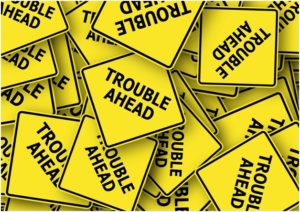October 20, 2019
 Do you know what your finances will look like five years from now? Life is full of ups and downs, and financial uncertainty can be both personal and universal. It’s hard to know where you’re going to be down the line, no matter how carefully you’ve planned.
Do you know what your finances will look like five years from now? Life is full of ups and downs, and financial uncertainty can be both personal and universal. It’s hard to know where you’re going to be down the line, no matter how carefully you’ve planned.
Causes of personal financial uncertainty include:
• Losing your job
• A decrease in income such as a pay cut or losing a client as a freelancer
• Injury or medical emergency, including medical bills and loss of income
• The need to care for aging parents
But even if your own prospects are positive and nothing unfortunate happens, the global economy can take a turn and leave you in the lurch as well. Some common causes of recessions include:
• Popping of an asset bubble, when overvalued values suddenly correct, leaving owners drowning in debt
• Rising interest rates that make banks less likely to finance debt
• Political causes, such as trade wars or regional tensions leading to reduced jobs and economic activity
Invest for Uncertainty
You can invest to plan for uncertainty. One of the chief benefits of investing in gold is that it gives you a tool you can use in downturns both personal and global. Whether you’re suffering personal financial troubles or the market as a whole is turning against investors, gold is a great way to ride through tough times.
How Gold Performs as an Asset Class
The last two recessions have both began with the bursting of an asset class. In 2000, it was the dot.com burst that caused $1.7 trillion to disappear from publicly traded internet companies like Cisco, AOL, and Yahoo. In 2008, it was the collapse of the real estate market – a fairly normal real estate bubble burst that spiralled into a global debt crisis.
Both times, gold prices improved dramatically. You can expect gold to perform well when other asset bubbles burst, especially if bullion is coming off a period of low prices or deflated prices. Investors have a chance to add precious metals at a low price and profit from the double-helix effect of riding through tough economic times.
Looking ahead to the near future, after a decade-long expansion, the stock market is due for a correction. Investing in gold now can help you get through the uncertainty unscathed.
Asset Liquidity
Gold is a liquid asset – meaning that it can be quickly converted to cash with little to no loss in value. Keep in mind that this is mostly true of gold bullion: 1 oz. coins and bars, as well as other forms with bullion-grade purity. Jewelry is not a sure investment bet.
But if you have the metal in bullion form, you can pretty much always find a market for it and sell quickly at no loss to value. When you run into personal financial trouble and you need to cash in an asset, you need to recoup the value. There’s no controlling when personal financial issues can come up; if you need to sell shares, but the company has just released poor quarterly earnings, you’re out of luck.
Investing in gold is a smart move for anyone who wants flexibility and security. Invest carefully today for a more comfortable tomorrow.
Tags:
Assets,
budgeting,
Business,
financial planning,
gold,
investments,
money,
Silver
April 30, 2016
 So, you’ve done your research. You know a well-balanced investment portfolio should ideally include exposure to bullion. But do you go with gold or silver? Truth be told, there’s no one correct answer to that question – at least not one that’s applicable to every investor. Learn the key differences between gold and silver and base your decision on factors including how long you plan to hold onto your investment, how much you are able to invest and what sort of risk profile you want to adopt. Remember, both metals offer inflationary protection and carry no credit risk, whilst each has taken its turn in the limelight as far as past price performance goes. The canniest of investors are likely to go for a long play investment in both metals. Read on, and find out more.
So, you’ve done your research. You know a well-balanced investment portfolio should ideally include exposure to bullion. But do you go with gold or silver? Truth be told, there’s no one correct answer to that question – at least not one that’s applicable to every investor. Learn the key differences between gold and silver and base your decision on factors including how long you plan to hold onto your investment, how much you are able to invest and what sort of risk profile you want to adopt. Remember, both metals offer inflationary protection and carry no credit risk, whilst each has taken its turn in the limelight as far as past price performance goes. The canniest of investors are likely to go for a long play investment in both metals. Read on, and find out more.
The Case for gold
Gold’s volatility factor is up to 70 percent lower than silver’s. Gold also carries more prestige. This is largely due to its rarity. The yellow metal is 18 times rarer than silver. And new discoveries are on the wane. Production has likewise fallen considerably over the last decade. Meanwhile, central banks are still buying up large quantities of the stuff, which is encouraging. Over the longer term, gold’s price has performed exceedingly well. Also in its favour is gold’s unrivalled status as the accepted alternative to currencies. The yellow metal has been used to store wealth for more than 3,000 years. You simply cannot say this of silver.
The case for silver
Silver has much going for it as a savvy investment choice, though its volatility means it is more speculative than gold. Notably, silver is more widely used in industrial applications. Whatsmore, the industries it’s used in – like, solar power and electronics – are growing. Sterling silver jewellery is still a popular gift idea and many people are indulging in silver jewelry for themselves as well. Silver’s price may be currently weak, yet it is this very weakness forcing producers to scale back operations. These aforementioned factors, at some point, are likely to affect silver’s supply and demand ratio to the point where its price will be pushed up. In addition, analysts concur silver may well offer investors better value than gold, as the gold/silver price ratio is currently further apart than it theoretically should be. Finally, even though VAT must be paid on silver purchases, it remains, of course, much cheaper per ounce than gold to buy. This offers those with even only US$1000 in capital to invest in bullion, an ‘in’ into the market.
To conclude
Silver or gold? Each is likely a good investment choice over the longer term. Yet as you’ve just read, they have their differences. Which is precisely why many advisors would suggest owning both. If you choose a total exposure to bullion amounting to 10 percent of your portfolio for instance, go ahead and split that 10 percent between silver and gold. How you weigh the split largely depends on your views on the health of the stock market and worldwide industrial growth.
Tags:
Assets,
Business,
economy,
gold,
investments,
money,
Silver
February 12, 2016
 Coin collecting is an interesting hobby pursued by many across the world. If you’re a lover of history or rare artifacts than coin collecting is for you and a good start could be with junk silver.
Coin collecting is an interesting hobby pursued by many across the world. If you’re a lover of history or rare artifacts than coin collecting is for you and a good start could be with junk silver.
Coin collecting refers to collecting coins ranging over many eras and made of different materials. Each coin tells a story in itself. The imprints on the coin signify an important event or a phase of a ruler. Some people also collect coins mainly to systematically study the evolution of modern day currency. Such systematic coin collecting is referred to as numismatics.
While coin collection is informative and engaging, there’s also a good monetary value attached to it. Many coin collectors also have gold and silver coins. Coins in the past that were silver in color had a component of actual silver in them. For example, dimes produced pre-1965 have 90% @0.07 oz of silver. This silver in today’s market will sell for over $2! Such coins containing silver in them are referred to as junk silver coins since they do not have any real historic value attached to them but provide monetary benefit to the coin bearer. Similarly, there are gold coins as well.
HowTo Begin
Coin collecting is not as difficult as it might appear. There are many places where coins are traded and to begin with, you can just purchase a few of them. You can follow the following steps to kick start your own collection of coins.
Figure out what kind of collection you wish to make – historic? Time series? Artistic?
Based on your interest, start reading up on what kind of coins you want to collect. Not knowing enough can mean that you don’t know the value of the coin even if it’s in front of you.
Look for places that offer coins for sale. Visit coin stores around and look them up on the internet. It is advisable; however, to not buy a coin without seeing it first.
Read up well about the coin, its historic or artistic importance, the era of usage etc. This will help you better understand the value of the coin.
You can also begin with simple roll of dimes and create a collection of all dimes year over year. This is a simple way to begin teaching coin collection to children. It is also a good motivator for beginners.Once you have a few coins, you can begin trading them for a coin you might find more interesting to add to your collection.
There are few tips that can prove very helpful in the coin collection process:
• Have patience – Coin collecting requires looking through many coins to find the one you want
• Set goals – Setting goals keeps you motivated and focused
• Seek help – Don’t shy away from seeking help from a professional or an experienced collector for advice.
Conclusion
Coin collecting is both a hobby and an investment. The value of the coins grows over years and rare coins can be sold any day. Coin collecting can be practiced over very long periods of time and can even be passed on generation after generation – building bonds and creating memories.
Tags:
Assets,
Business,
economy,
gold,
investments,
Precious Metals,
Silver
 Do you know what your finances will look like five years from now? Life is full of ups and downs, and financial uncertainty can be both personal and universal. It’s hard to know where you’re going to be down the line, no matter how carefully you’ve planned.
Do you know what your finances will look like five years from now? Life is full of ups and downs, and financial uncertainty can be both personal and universal. It’s hard to know where you’re going to be down the line, no matter how carefully you’ve planned.


Recent Comments